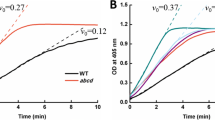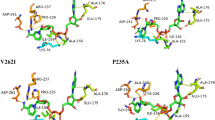Abstract
The organophosphorus hydrolase (OPH) has been used to degrade organophosphorus chemicals, as one of the most frequently used decontamination methods. Under chemical and thermal denaturing conditions, the enzyme has been shown to unfold. To utilize this enzyme in various applications, the thermal stability is of importance. The engineering of de novo disulphide bridges has been explored as a means to increase the thermal stability of enzymes in the rational method of protein engineering. In this study, Disulphide by Design software, homology modelling and molecular dynamics simulations were used to select appropriate amino acid pairs for the introduction of disulphide bridge to improve protein thermostability. The thermostability of the wild-type and three selected mutant enzymes were evaluated by half-life, ΔG inactivation (ΔGi) and structural studies (fluorescence and far-UV CD analysis). Data analysis showed that half-life of A204C/T234C and T128C/E153C mutants were increased up to 4 and 24 min, respectively; however, for the G74C/A78C mutant, the half-life was decreased up to 9 min. For the T128C/E124C mutant, both thermal stability and Catalytic efficiency (kcat) were also increased. The half-life and ΔGi results were correlated to the obtained information from structural studies by circular dichroism (CD) spectrometry and extrinsic fluorescence experiments; as rigidity increased in A204C/T2234C and T128C/E153C mutants, half-life and ΔGi also increased. For G74C/A78C mutant, these parameters decreased due to its higher flexibility. The results were submitted a strong evidence for the possibility to improve the thermostability of OPH enzyme by introducing a disulphide bridge after bioinformatics design, even though this design would not be always successful.







Similar content being viewed by others
References
Abdel-Razek MA-RS, Folch-Mallol JL, Perezgasga-Ciscomani L, Sánchez-Salinas E, Castrejón-Godínez ML and Ortiz-Hernández ML 2013 Optimization of methyl parathion biodegradation and detoxification by cells in suspension or immobilized on tezontle expressing the opd gene. J. Environ. Sci. Health B. 48 449–461
Aitken A and Learmonth M 2002 Estimation of disulfide bonds using Ellman’s reagent. The protein protocols handbook (Springer) pp 595–596
Almoazen H, Bhattacharjee H, Samsa AC and Pate S 2010 Stability of mesna in ReadyMed infusion devices. Ann. Pharmacother. 44 224–225
Amini-Bayat Z, Hosseinkhani S, Jafari R and Khajeh K 2012 Relationship between stability and flexibility in the most flexible region of Photinus pyralis luciferase. Biochim. Biophys. Acta (BBA) Proteins Proteomics. 1824 350–358
Armstrong CD 2007 Elucidating the chemical and thermal unfolding profiles of organophosphorus hydrolase and increasing its operational stability (Texas A&M University)
Ásgeirsson B, Adalbjörnsson BV and Gylfason GA 2007 Engineered disulfide bonds increase active-site local stability and reduce catalytic activity of a cold-adapted alkaline phosphatase. Biochim. Biophys. Acta (BBA) Proteins Proteomics. 1774 679–687
Briseño-Roa L, Oliynyk Z, Timperley CM, Griffiths AD and Fersht AR 2011 Highest paraoxonase turnover rate found in a bacterial phosphotriesterase variant. Protein Eng. Des. Sel. 24 209–211
Bulaj G, Kortemme T and Goldenberg DP 1998 Ionization-reactivity relationships for cysteine thiols in polypeptides. Biochemistry 37 8965–8972
Chakravarty S and Varadarajan R 2002 Elucidation of factors responsible for enhanced thermal stability of proteins: a structural genomics based study. Biochemistry 41 8152–8161
Cheng T, Harvey SP and Chen GL 1996 Cloning and expression of a gene encoding a bacterial enzyme for decontamination of organophosphorus nerve agents and nucleotide sequence of the enzyme. Appl. Environ. Microbiol. 62 1636–1641
Chu X-y, Tian J, Wu N-f and Fan Y-l 2010 An intramolecular disulfide bond is required for the thermostability of methyl parathion hydrolase, OPHC2. Appl. Microbiol. Biotechnol. 88 125–131
D'Amico S, Gerday C and Feller G 2003 Temperature adaptation of proteins: engineering mesophilic-like activity and stability in a cold-adapted alpha-amylase. J. Mol. Biol. 332 981–988
Danson MJ, Hough DW, Russell RJ, Taylor GL and Pearl L 1996 Enzyme thermostability and thermoactivity. Protein Eng. 9 629–630
Di Sioudi BD, Miller CE, Lai K, Grimsley JK and Wild JR 1999 Rational design of organophosphorus hydrolase for altered substrate specificities. Chem. Biol. Interact. 119 211–223
Dombkowski AA 2003 Disulfide by Design™: a computational method for the rational design of disulfide bonds in proteins. Bioinformatics 19 1852–1853
Dombkowski AA, Sultana KZ and Craig DB 2014 Protein disulfide engineering. FEBS Lett. 588 206–212
Ely F, Hadler K, Gahan L, Guddat L, Ollis D and Schenk G 2010 The organophosphate-degrading enzyme from Agrobacterium radiobacter displays mechanistic flexibility for catalysis. Biochem. J. 432 565–573
Farnoosh G and Latifi AM 2014 A review on engineering of Organophosphorus Hydrolase (OPH) enzyme. J. Appl. Biotechnol. Rep. 1
Froger A and Hall JE 2007 Transformation of plasmid DNA into E. coli using the heat shock method. J. Vis. Exp. JoVE.
Ghanem E and Raushel FM 2005 Detoxification of organophosphate nerve agents by bacterial phosphotriesterase. Toxicol. Appl. Pharmacol. 207 459–470
Gokhale RS, Agarwalla S, Francis V, Santi DV and Balaram P 1994 Thermal stabilization of thymidylate synthase by engineering two disulfide bridges across the dimer interface. J. Mol. Biol. 235 89–94
Gomes DE, Lins RD, Pascutti PG, Lei C and Soares TA 2009 The role of nonbonded interactions in the conformational dynamics of organophosphorous hydrolase adsorbed onto functionalized mesoporous silica surfaces. J. Phys. Chem. B. 114 531–540
Grote A, Hiller K, Scheer M, Münch R, Nörtemann B, Hempel DC and Jahn D 2005 JCat: a novel tool to adapt codon usage of a target gene to its potential expression host. Nucleic Acids Res. 33 W526–W531
Haghani K, Salmanian A, Ranjbar B, Zakikhan-Alang K, Khajeh K. 2007. Comparative studies of wild type Escherichia coli 5-enopyruvylshikimate 3-phosphate synthase with three glyphosate-intensive mutated forms: Activity, stability and structural characterization. Biochim. Biophys. Acta.
Haghani K, Salmanian AH, Ranjbar B, Zakikhan-Alang K and Khajeh K 2008 Comparative studies of wild type Escherichia coli 5-enolpyruvylshikimate 3-phosphate synthase with three glyphosate-insensitive mutated forms: activity, stability and structural characterization. Biochim. Biophys. Acta (BBA) Proteins Proteomics. 1784 1167–1175
Han Z-l, Han S-y, Zheng S-p and Lin Y 2009 Enhancing thermostability of a Rhizomucor miehei lipase by engineering a disulfide bond and displaying on the yeast cell surface. Appl. Microbiol. Biotechnol. 85 117–126
Hawwa R, Larsen SD, Ratia K and Mesecar AD 2009 Structure-based and random mutagenesis approaches increase the organophosphate-degrading activity of a phosphotriesterase homologue from Deinococcus radiodurans. J. Mol. Biol. 393 36–57
Imani M, Hosseinkhani S, Ahmadian S and Nazari M 2010 Design and introduction of a disulfide bridge in firefly luciferase: increase of thermostability and decrease of pH sensitivity. Photochem. Photobiol. Sci. 9 1167–1177
Jeong M-Y, Kim S, Yun C-W, Choi Y-J and Cho S-G 2007 Engineering a de novo internal disulfide bridge to improve the thermal stability of xylanase from Bacillus stearothermophilus No. 236. J. Biotechnol. 127 300–309
Kachooei E, Moosavi-Movahedi AA, Khodagholi F, Mozafarian F, Sedeghi P, Hadi-Alijanvand H, Ghasemi A, Saboury AA, et al. 2014 Inhibition study on insulin fibrillation and cytotoxicity by paclitaxel. J. Biochem. mvu012
Kazan D, Ertan H and Erarslan A 1997 Stabilization of Escherichia coli penicillin G acylase against thermal inactivation by cross-linking with dextran dialdehyde polymers. Appl. Microbiol. Biotechnol. 48 191–197
Kim J, Kim S, Yoon S, Hong E and Ryu Y 2015 Improved enantioselectivity of thermostable esterase from Archaeoglobus fulgidus toward (S)-ketoprofen ethyl ester by directed evolution and characterization of mutant esterases. Appl. Microbiol. Biotechnol. 1–9
Le QAT, Joo JC, Yoo YJ and Kim YH 2012 Development of thermostable Candida antarctica lipase B through novel in silico design of disulfide bridge. Biotechnol. Bioeng. 109 867–876
Micsonai A, Wien F, Kernya L, Lee Y-H, Goto Y, Réfrégiers M and Kardos J 2015 Accurate secondary structure prediction and fold recognition for circular dichroism spectroscopy. Proc. Natl. Acad. Sci. 201500851.
Milani MM, Lotfi AS, Mohsenifar A, Mikaili P, Kamelipour N and Dehghan J 2015 Enhancing organophosphorus hydrolase stability by immobilization on chitosan beads containing glutaraldehyde. Res. J. Environ. Toxicol. 9 34
Paliwal S 2008 Development of enzyme-based biosensors for the detection of organophosphate neurotoxins: ProQuest
Pawlowski PH and Zielenkiewicz P 2013 Theoretical model explaining the relationship between the molecular mass and the activation energy of the enzyme revealed by a large-scale analysis of bioinformatics data. Acta Biochim. Pol. 60 239–247
Pinkerton TS 2005 The recombinant expression and potential applications of bacterial organophosphate hydrolase in Zea mays L (Texas A&M University)
Porto ALM, Melgar GZ, Nitschke M, Kasemodel MC 2011 Biodegradation of pesticides: INTECH Open Access Publisher
Rashnoo F, Khajeh K, Mollania N and Ranjber B 2011 Improving the thermal stability of laccase from Bacillus sp. HR03 by site-directed mutagenesis at Asn143Pro. Clin. Biochem. 44 S91
Riddles PW, Blakeley RL and Zerner B 1979 Ellman's reagent: 5, 5′-dithiobis (2-nitrobenzoic acid)—a reexamination. Anal. Biochem. 94 75–81
Sani MR, Moghaddam MM, Aghamollaei H, Hassanpour K, Taheri RA and Farnoosh G 2014 Investigation of caspase-1 activity and interleukin-1beta production in murine macrophage cell lines infected with Leishmania major. Asian Pac. J. Trop. Med. 7S1 S70–S73
Siadat OR, Lougarre A, Lamouroux L, Ladurantie C and Fournier D 2006 The effect of engineered disulfide bonds on the stability of Drosophila melanogaster acetylcholinesterase. BMC Biochem. 7 12
Su Y, Tian J, Wang P, Chu X, Liu G, Wu N and Fan Y 2011 Improving the thermostability of a methyl parathion hydrolase by adding the ionic bond on protein surface. Appl. Biochem. Biotechnol. 165 989–997
Theriot CM and Grunden AM 2011 Hydrolysis of organophosphorus compounds by microbial enzymes. Appl. Microbiol. Biotechnol. 89 35–43
Tian J, Wang P, Gao S, Chu X, Wu N and Fan Y 2010 Enhanced thermostability of methyl parathion hydrolase from Ochrobactrum sp. M231 by rational engineering of a glycine to proline mutation. FEBS J. 277 4901–4908
Tian J, Wang P, Huang L, Chu X, Wu N and Fan Y 2013 Improving the thermostability of methyl parathion hydrolase from Ochrobactrum sp. M231 using a computationally aided method. Appl. Microbiol. Biotechnol. 97 2997–3006
Ugarova N and Koksharov M 2012 Thermostabilization of firefly luciferases using genetic engineering: INTECH Open Access Publisher
Vivian JT and Callis PR 2001 Mechanisms of tryptophan fluorescence shifts in proteins. Biophys. J. 80 2093–2109
Yang H, Yao B, Meng K, Wang Y, Bai Y and Wu N 2007 Introduction of a disulfide bridge enhances the thermostability of a Streptomyces olivaceoviridis xylanase mutant. J. Ind. Microbiol. Biotechnol. 34 213–218
Yang H, Carr P, McLoughlin SY, Liu J, Horne I, Qiu X, Jeffries C, Russell R, et al. 2003 Evolution of an organophosphate-degrading enzyme: a comparison of natural and directed evolution. Protein Eng. 16 135–145
Yin X, Hu D, Li J-F, He Y, Zhu T-D and Wu M-C 2015 Contribution of disulfide bridges to the thermostability of a type a feruloyl esterase from aspergillus usamii. PloS One 10
Zuker M 2003 Mfold web server for nucleic acid folding and hybridization prediction. Nucleic Acids Res. 31 3406–3415
Acknowledgements
We thank the manager and colleagues at the Applied Biotechnology Research Centre, Baqiyatallah University of Medical Sciences, Tehran, Iran, for useful discussions and critical reading of the manuscript.
This paper is extracted from Gholamreza Farnoosh’s PhD dissertation of the research project of Applied Biotechnology Research Center of Baqiyatallah University of Medical Sciences.
Author information
Authors and Affiliations
Corresponding author
Additional information
Corresponding editor: María Eliano Lanio
[Farnoosh G, Khajeh K, Latifi AM and Aghamollaei H 2016 Engineering and introduction of de novo disulphide bridges in organophosphorus hydrolase enzyme for thermostability improvement. J. Biosci.]
Rights and permissions
About this article
Cite this article
Farnoosh, G., Khajeh, K., Latifi, A.M. et al. Engineering and introduction of de novo disulphide bridges in organophosphorus hydrolase enzyme for thermostability improvement. J Biosci 41, 577–588 (2016). https://doi.org/10.1007/s12038-016-9643-8
Received:
Accepted:
Published:
Issue Date:
DOI: https://doi.org/10.1007/s12038-016-9643-8




